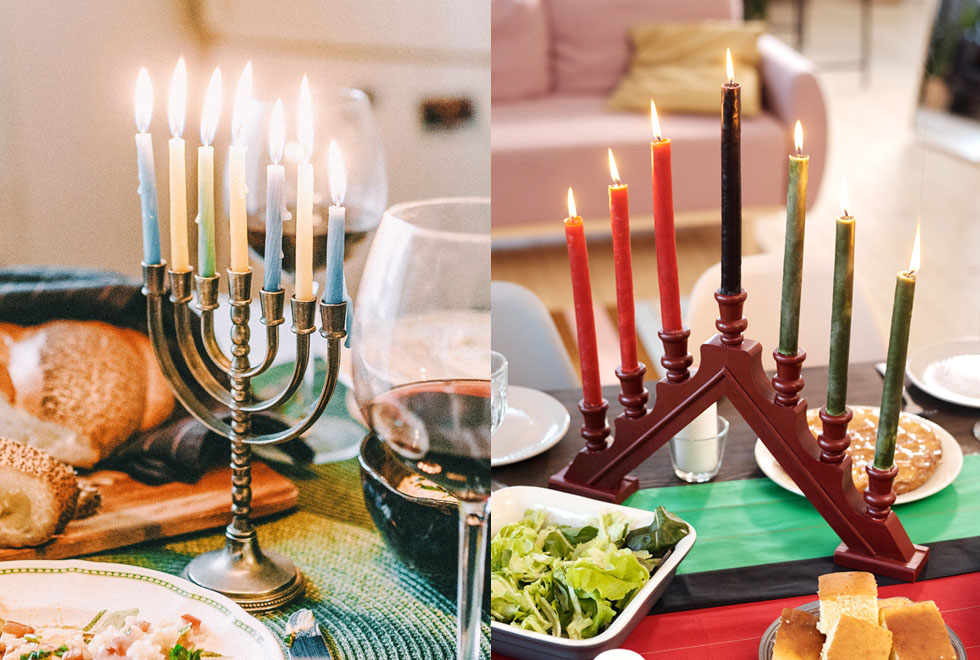The holidays are here, and we all know how easy it is to get caught up in the holiday spirit. Whether you’re preparing to celebrate Hannukah, Christmas, or Kwanzaa, these festivals are filled with beautiful traditions, meaningful time with family, culture, and more.
Each of these winter holidays also presents a beautiful opportunity to celebrate in a more environmentally-friendly way! I previously wrote about my favorite ways to “go green” during Christmas. Now, I’ll focus on some clever ways to make your Hanukkah and Kwanzaa celebrations more eco-friendly.
Hannukah Gone Green
Hanukkah is also called the Festival of Lights. It commemorates the miracle that the one-day oil supply lasted eight days when the Jewish people rededicated the Temple after the Maccabean Revolt.
One of the callings or commands in the Jewish faith is to work to make the world a more just, peaceful, and equitable place. Making environmentally-conscious choices can certainly be part of that calling! Here are some easy ways to make your Hanukkah celebrations more eco-friendly.
Use environmentally friendly candles
Skip the petroleum-based Hanukkah candles and invest in more eco-friendly candles that burn cleanly. Not only are they more earth-friendly, but they’re also healthier for the family as you burn them.
Beeswax and soy candles are more natural options. Several companies sell beeswax Hanukkah candles. GoodLight Natural Candles even sells Hanukkah candles that are non-toxic and support sustainable palm farming.
Another eco-friendly Hanukkah candle option is Rite Lite organic Hanukkah Candles. They’re dye-free, hand-dipped candles with pure cotton wicks. Even the packaging is made with recycled materials.
Go local for latke ingredients
Potatoes, onions, and other root veggies are abundant during winter. Consider purchasing your latke ingredients from local farmers to reduce the greenhouse gasses from transporting food.
You can also green up your latke toppings by making your own applesauce from locally grown apples (or buying an organic brand).
Many people are also going beyond the traditional latke toppings! Consider making your own basil pesto topping, or try this delicious apple salsa with local or organic ingredients.
Choose sustainable dreidels and hanukkiahs
The hanukkiah is at the center of the Hanukkah celebration with spaces for nine candles–representing the eight nights of Hanukkah and the Shamash (helper candle).
When shopping for hanukkiahs and dreidels, look for options made with sustainable materials that will last a lifetime.
Hanukkiahs are made from all kinds of materials like metal, glass, and ceramic. Any locally made items will have a lower environmental impact. Consider shopping at your local Judaica shop to support a local business and reduce carbon emissions.
Dreidel is a fun traditional Hanukkah game that everyone looks forward to. If you’re shopping for new dreidels this year, avoid the plastic ones and choose ones made of wood. They’ll last longer and are more environmentally friendly.
Wrap the gifts in recycled paper
Wrappily has some beautiful Hanukkah-themed wrapping paper that is made from recycled materials. Graphic Anthology is a great place to buy eco-friendly Hanukkah cards that are sustainably produced.
Environmentally Friendly Kwanzaa Ideas
Kwanzaa begins on December 26th and lasts until January 1st. It’s a week-long celebration honoring African-American and Pan-African heritage and culture.
There are seven principles of Kwanzaa: Unity (Umoja), Self-determination (Kujichagulia), Collective works and responsibility (Ujima), Cooperative economics (Ujamaa), Purpose (Nia), Creativity (Kuumba), and Faith (Imani).
One way to honor the principle of Ujima (collective works and responsibility) is to make your Kwanzaa festivities more environmentally conscious. After all, the condition of the environment impacts us all.
Cook traditional family recipes mindfully
Spend time cooking traditional family recipes. Family recipes always taste better than the store-bought version and tend to be more environmentally friendly than pre-packaged options. As you’re shopping for ingredients, choose locally-grown produce. When possible, select ingredients with less plastic packaging, too.
Go green with gifts
One Kwanzaa tradition is to give children gifts about African culture and a symbol of their African heritage. Consider shopping at local or small businesses to reduce the carbon footprint that comes with packing and shipping items long distances.
Another way to “go green” with your gifts is to make your own books. What a fantastic way to spend time together and make your celebrations more eco-friendly.
Learn about environmental justice as part of your Kwanzaa journey
In 2013, at least 68% of African-Americans lived within 30 miles of a coal-fired power plant. Poor and minority Americans are more likely to endure the consequences of air pollution and other environmental damages.
In the spirit of Kujichangulia (self-determination) and Umoja (unity), take time to learn about small ways you can make environmentally-conscious decisions in the coming year. Discover ways you can fight air pollution and climate insecurities.
One excellent learning resource is Hip Hop Caucus Think 100. The hosts of Think 100 are powerful leaders in environmental justice, and they produce award-winning shows that assess real climate problems that impact communities of color. Their message is simple: climate action is not boring, depressing, or scary–it’s exciting, and everyone should participate.
No matter how you decide to celebrate the holidays this year, I hope you choose one or two ways to make your festivities just a little more eco-friendly. And above all, I hope you have a safe and healthy 2023!
–
Other Works Cited
https://www.sierraclub.org/sierra/2013-6-november-december/green-life/emphasizing-green-kwanzaa
https://nmaahc.si.edu/explore/stories/seven-principles-kwanzaa
